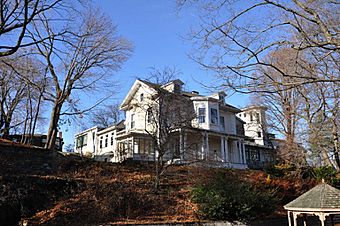William Lloyd Garrison House facts for kids
|
William Lloyd Garrison House
|
|
|
U.S. Historic district
Contributing property |
|
 |
|
| Location | Boston, Massachusetts |
|---|---|
| Area | 0.74 acres (0.30 ha) |
| Built | ca. 1840s |
| Part of | Roxbury Highlands Historic District (ID89000147) |
| NRHP reference No. | 66000653 |
Quick facts for kids Significant dates |
|
| Added to NRHP | October 15, 1966 |
| Designated NHL | June 23, 1965 |
| Designated CP | February 22, 1989 |
The William Lloyd Garrison House, also known as Rockledge, is a very important historic house in Boston, Massachusetts. It's located at 125 Highland Street in the Roxbury Highlands part of the city. This house was the home of William Lloyd Garrison (1805–1879). He was a famous leader in the fight to end slavery in the United States during the mid-1800s.
Garrison published a newspaper called The Liberator. This newspaper was a main voice for the movement to free all enslaved people right away. The house was probably built in the 1840s or 1850s. Even though it has been changed a bit over time, it still looks much like it did in the 1800s. In 1965, it was named a National Historic Landmark, which means it's a place of great national importance.
Contents
The Story of the Garrison House
We don't know exactly when or by whom this house was first built. William Lloyd Garrison bought it in 1864. He lived there until he passed away in 1879.
After Garrison's death, a group of African-American supporters formed a non-profit called the Rockledge Associates. They bought the house to keep it safe as a memorial to Garrison. Later, in 1904, a group of nuns called the Episcopal Sisters of the Society of St. Margaret bought the house. They changed it to create a home for older people who needed help. In 2012, Emmanuel College bought the property. They now use it as part of their campus.
Who Was William Lloyd Garrison?
William Lloyd Garrison (1805–1879) was born in Newburyport, Massachusetts. He learned how to be a printer. From a young age, he was involved in the cause to end slavery.
Starting The Liberator
In 1830, Garrison started publishing his newspaper, The Liberator. Even though it didn't have a huge number of readers, it became the most important newspaper for the movement to end slavery. In its pages, Garrison always called for all enslaved people to be freed immediately.
Garrison's Strong Beliefs
Garrison's message was very strong and clear. He didn't compromise. This upset not only people who owned slaves but also some business owners who were against slavery but wanted a more moderate approach. Because of his strong beliefs, Garrison and his supporters sometimes faced violence. In one famous event in Boston in 1835, a mob attacked Garrison. He barely escaped serious injury.
Fighting for Freedom
In 1842, Garrison even suggested that the United States should split apart if slavery wasn't abolished. His tireless work and strong arguments helped create a moral reason for the actions of people in the North during the American Civil War (1861–65).
Garrison stopped publishing The Liberator in 1865, after slavery was finally ended. He then mostly retired to his home, Rockledge. However, he continued to work for other important social causes until he died.
What the House Looks Like
The main parts of the Garrison house are its two-story front section and a two-story section that extends to the back. The house sits on a rock ledge, looking over a grassy park below.
Architectural Style
The house has an Italianate style. Some parts of its original look have been changed over time, but some details were later put back. The front of the house has three sections, with a porch that goes all the way across the front. The porch is now held up by square columns. These are newer columns that replaced the more decorative ones from the 1800s.
The main front door has windows on either side. It's framed by a decorative border that forms a clover-like shape at the top. The corners of the house have special decorative blocks called quoins. These were removed at one point but later put back.
Later Additions
Above the main entrance, there's a window that sticks out, called an oriel window. This was added in the 1900s. Also, a glassed-in porch was added to the left side of the house in the 1900s. The back part of the house also has a bay window that was added later. An older, one-story section at the back was replaced with a two-story square structure with a special roof called a mansard roof.
Inside the house, only the entrance hall and the main living room (to the right of the entrance) still look mostly like they did when Garrison lived there.



